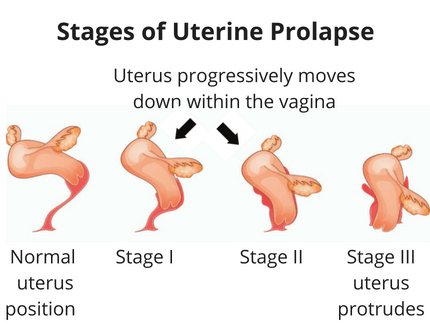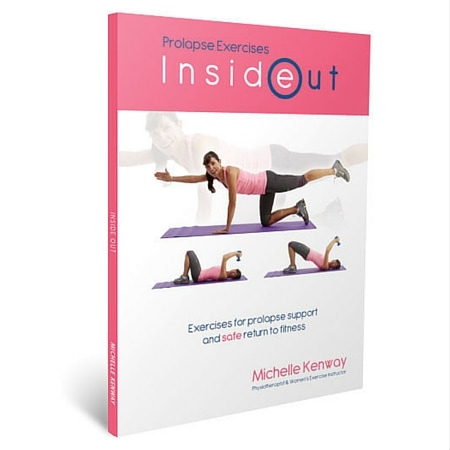Are uterine prolapse symptoms bothering you?
This Physical Therapist information teaches you how to recognise common uterine prolapse symptoms and simple ways to avoid prolapse worsening.
Read on now to learn:
- What causes uterine prolapse symptoms
- Common uterine prolapse symptoms
- How to relieve uterine prolapse symptoms
- Simple ways to avoid uterine prolapse symptoms worsening
What Causes Uterine Prolapse Symptoms?
Uterine prolapse also known as prolapsed womb is one form of prolapse where the uterus (womb) and cervix (opening to womb) move down within the vagina. With severe uterine prolapse the uterus protrudes out of the vagina (Stage III shown below).

Uterine prolapse symptoms can occur suddenly (for example after childbirth) or progressively worsen over time as the tissues that suspend and support the uterus weaken and stretch (for example chronic straining with constipation).
Prolapse Exercises e-Book
International best selling prolapse exercise guide for women with prolapse and after prolapse surgery.
Prolapse Exercises teaches you how to:
- Exercise safely after prolapse surgery
- Reduce your risk or repeat prolapse
- Avoid unsafe exercises
- Choose pelvic floor safe exercises
- Reduce your risk of prolapse worsening
- Improve prolapse support
- Increase your strength and fitness
- Strengthen your core
- Lose weight
Common Uterine Prolapse Symptoms
Uterine prolapse symptoms usually become more troublesome as the prolapse worsens. Symptoms typically include:
- Bulging heavy feeling inside the vagina
- Feeling that a lump or ball is moving down inside the vagina (this lump or uterine prolapse may be visible at the entrance of your vagina shown below)
- Heaviness in the lower belly or abdomen
- Difficulty inserting a tampon
- Difficulty with bladder or bowel emptying
- Lower back ache or discomfort.

If your uterine prolapse is mild (Stage I above) you may not notice prolapse symptoms.
Uterine prolapse symptoms usually worsen towards the end of the day as the uterus and supporting tissues stretch inside especially with moderate to severe prolapse.
How to Relieve Uterine Prolapse Symptoms
There are a number of things you can do at home to reduce symptoms of prolapsed uterus.
The key to reducing your prolapse symptoms is being aware of the activities that place downward pressure and strain on your uterus and cervix during the course of the day.
To relieve prolapse symptoms:
- Do your pelvic floor exercises or Kegels at the start of your day (before your prolapsed tissues stretch)
- Rest when you can – sitting with feet up on a low stool and lying down are preferable to prolonged standing
- Wear support briefs that are well fitted over the low abdomen (without lace or thick elastic waist)
- Use the correct bowel emptying technique
- Keep your stool consistency soft and well formed with appropriate diet, fluid intake or medication as required
- Manage coughing with hay fever, chest conditions (e.g. asthma) using appropriate medication
- Speak with your doctor about the use of a support pessary.
Simple Ways to Avoid Uterine Prolapse Symptoms Worsening

- Commit to doing pelvic floor exercises (Kegels) long-term
- Avoid heavy lifting
- Avoid repetitive lifting
- Choose low impact supported general exercises e.g. stationary bike
- Avoid high impact exercises
- Avoid intense abdominal core exercises
- Spread working activities during the course of the day e.g. housework
- Reduce prolonged standing by sitting or lying down during the course of the day
- Avoid straining with constipation or diarrhoea
- Avoid smoking
- Manage your body weight
- Lose weight if you’re overweight
- Wearing a well fitted support pessary may reduce uterine prolapse worsening.
Further Reading
» Uterine Prolapse – The Do’s and Don’ts Women Want to Know
» How to Manage Uterine Prolapse after Childbirth
» How Pessaries Can Help Prolapse Symptoms And Support
ABOUT THE AUTHOR, Michelle Kenway
Michelle Kenway is an Australian Pelvic Floor Physiotherapist. Michelle lectures to health professionals and promotes community health through her writing, radio segments, online exercise videos and community presentations. She holds dual post graduate physiotherapy qualifications in women’s health and exercise.








